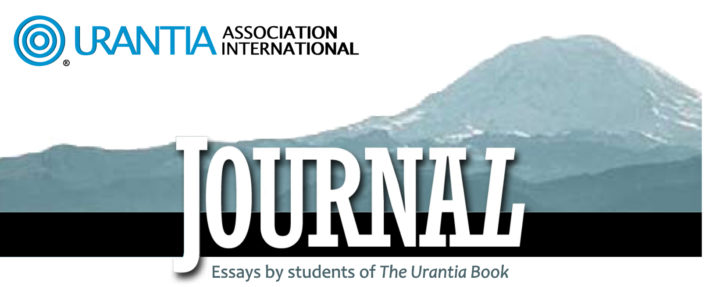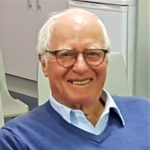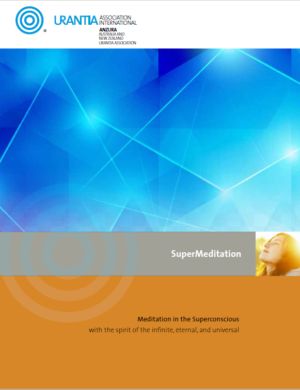© 2019 Suzanne Kelly, Jeannie Vazquez, Mark Blackham, William Wentworth, Neil Francey
© 2019 International Urantia Association (IUA)

(Note: To print a hard copy of this Journal click the “Print Version” button above. After the print version appears, right-click into any white space and choose “Print.”)
¶ In This Issue
- Journal Editorial May 2019 – Suzanne Kelly, USA
- The Function of Prayer to Strengthen Our Faith – Jeannie Vazquez, Uruguay
- Worship—A Son’s Experience – Mark Blackham, Canada
- The Meaning of Worship and Service – William Wentworth, Australia
- SuperMeditation – Neil Francey, Australia
- About the Journal
¶ Journal Editorial May 2019
Suzanne Kelly, USA
Greetings Fellow Urantia Book Readers,

The first production of the Journal for 2019 highlights authors from around the world and their in-depth presentations of those portions of the book that spoke to them personally. In sharing their experiences, we hope you will discover a greater understanding as well.
Our first essay by Jeanne Vasquez from Uruguay**, The Function of Prayer to Strengthen our Faith,** was presented at the 2nd Latin-American Conference, São Paulo, Brazil, on November 2018. To clarify her understanding of faith and the function of prayer in making her faith stronger, she first examines this quote:
Belief has attained the level of faith when it motivates life and shapes the mode of living. The acceptance of a teaching as true is not faith; that is mere belief. Neither is certainty nor conviction faith. A state of mind attains to faith levels only when it actually dominates the mode of living. Faith is a living attribute of genuine personal religious experience. One believes truth, admires beauty, and reverences goodness, but does not worship them; such an attitude of saving faith is centered on God alone, who is all of these personified and infinitely more. [UB 101:2.1]
¶ The Function of Prayer to Strengthen Our Faith
Jeannie Vazquez, Uruguay
(Adapted from a presentation given at the 2nd Latin-American Conference, São Paulo, Brazil, on November 2018)

To start the analysis of this subject and to understand more clearly the function of prayer in the strengthening of our faith by making it experiential, living, and growing faith, let’s start by seeing what faith actually is.
Belief has attained the level of faith when it motivates life and shapes the mode of living. The acceptance of a teaching as true is not faith; that is mere belief. Neither is certainty nor conviction faith. A state of mind attains to faith levels only when it actually dominates the mode of living. Faith is a living attribute of genuine personal religious experience. One believes truth, admires beauty, and reverences goodness, but does not worship them; such an attitude of saving faith is centered on God alone, who is all of these personified and infinitely more. [UB 101:8.1]
According to this quote, a belief in divine teaching, even a belief in The Urantia Book, unless it gradually becomes a living reality in ourselves, is not faith. Faith is a living attribute of genuine personal religious experience [UB 101:8.1], and this experience has its origin in the spiritual presences that guide us.
Let us consider how we can progress from a mere intellectual belief in God and the divine teaching delivered to us by his Sons, to the application of these teachings in our lives. In my view, to attain such progress, it is essential to make a sincere consecration to seek divine realities and spiritual and eternal objectives. This consecration enables us to make the decisions and carry out the actions that realize our eternal destiny. The revelator in The Urantia Book says:
¶ Worship—A Son’s Experience
Mark Blackham, Canada

The Life Experience
I write this account as a way of sharing my personal religious experience in the acquired art of worship. For me, the telling is somewhat therapeutic and, for others who may have encountered similar circumstances in their lives, I hope it can serve as a positive affirmation.
Worship is simply the feeling or expression of reverence and adoration for Deity. It is an extraordinary act of personal communion with the living presence of God. It is a way of tapping into a divinely creative power to bring about positive transformations of character, and it can provide remarkable spiritual insights. This is why The Urantia Book urges us to worship on a daily basis.
But over the years, I discovered that many spiritual seekers, including many readers of The Urantia Book, have difficulty engaging in sincere worship. This was certainly the case for me. It took me a long time to overcome this stumbling block, and I was able to do so only through some deep reflection, timid prayer, and the kind assistance of others. My ability to worship in a wholehearted manner was not something that came to me all at once, but rather bit by bit over an extended period.
I discovered the revelation at the age of twenty-three. From the moment I began to read it, I was convinced I had found the truth. At first, I was particularly drawn to the historical and scientific content, subjects that I readily absorbed. But, in retrospect, my understanding of the spiritual content was severely limited.
¶ The Meaning of Worship and Service
William Wentworth, Australia
(Presented at the Hobart Anzura Conference, October 2010)
¶ The Meaning of Worship

The urge to worship appears naturally with the activation of the sixth adjutant mind-spirit. In humans, the urge to worship and the capacity for it are innate. Although we all experience this urge as individuals and in our own way, in its most basic form, worship is the recognition and honoring of the mysterious and incomprehensible cause and motivator of everything.
Worship has evolved through many phases—animal worship, nature worship, polytheism, pantheism and so on—until in monotheism we come to recognize God as both the cause and source of everything and, as revealed to us most recently by Jesus, as a benevolent personality who loves us and has a place for each of us.
Worship is recognizing and honoring God as a father, but is it also the recognition of the non-personal aspect of deity? I think it is. Jesus defines worship as:
“…the act of a part identifying itself with the Whole; the finite with the Infinite; the son with the Father; time in the act of striking step with eternity. Worship is the act of the son’s personal communion with the divine father, the assumption of refreshing, creative, fraternal and romantic attitudes by the human soul-spirit.” [UB 143:7.8]
For Jesus, worship consists of both personal communion with the Father and recognition of the Infinite as the source of everything. It is worth bearing in mind that this second aspect of worship is suggested by Jesus, and that our attempts at personal communion with the Father are also bound up with our recognition of the source of reality and the divine plan of progression. In a sense, we worship God because we know something about him—about who he is and what he is doing.
¶ SuperMeditation
Neil Francey, Australia

…Meditation in the Superconscious with the Spirit of the Infinite, Eternal, and Universal
This is a comprehensive work based on the Urantia Papers that explores meditation in its ultimate form: SuperMeditation. It is based on the highest revelatory truths of the modern age.
SuperMeditation links our day-to-day life with spirit influences. It is not a quick and easy method. It works in a natural way over time and seeks to balance all attributes, powers and components of our being. There is no set method or sequence for the study of these modules. They need to be studied and applied in practical life circumstances.
SuperMeditation is the connection of material reality and our spiritual nature through the thinking mechanism we call mind. By attempting this liaison we develop our ability to face the demands of living more effectively.
¶ About the Journal

The Journal is produced twice yearly and contains essays, articles and study aids by readers and for readers of The Urantia Book. Any interpretations, opinions, conclusions, or artistic representations, whether stated or implied, are those of the authors and do not necessarily represent the views and opinions of Urantia Association International, the National or Local Urantia Associations, or the editorial team of the Association’s Journal.
You can view the entire collection of issues in the archives. All issues before 2017 are downloadable PDF format.
The Journal is currently published in English, French and Spanish. (There are some older issues that were published in Finnish.) You can view the French and Spanish Journals by clicking on the language choices in the pull down menu at the top of the page.
- Subscriptions
- Journal Team
- Submission Policy
- Citation Guidelines